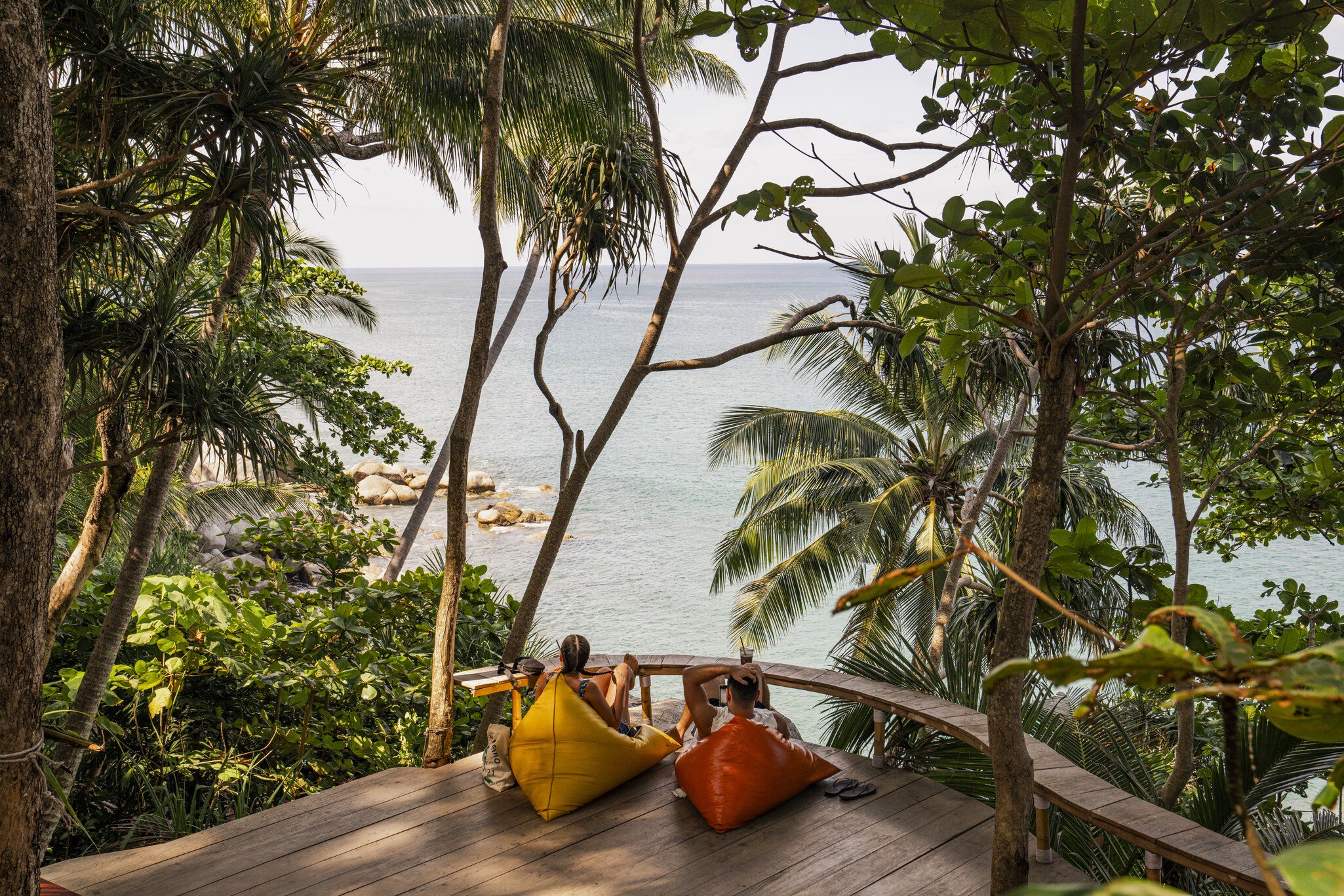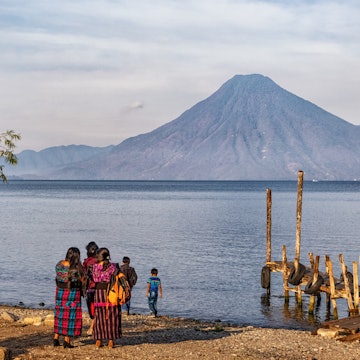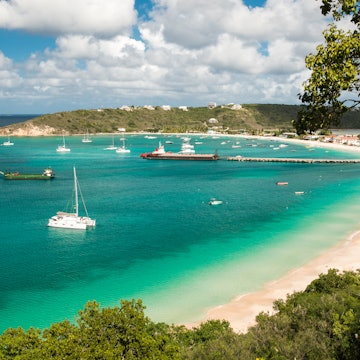

A volcano on Isla de Ometepe. Simon Dannhauer/Shutterstock
Depending where you begin your journey, a trip to the Caribbean might force you to choose between a long road trip or a costly flight. And it's worth it to get to Nicaragua, where gorgeous beaches vie with volcanic peaks for your attention.
The western lowlands of Nicaragua (where 90% of the population lives) are well connected with highways, buses and shuttles, and travelers should have little problem zipping between hot spots. The cost varies considerably for each method of transport, from budget mass transit to pricier private options. To help you plan your trip, read on for options.
Know your airport options
The hub for domestic flights is Managua International Airport. Other airports are little more than dirt strips outside town (or in Siuna and Waspám, in the middle of town). The airport in San Juan de Nicaragua is located across the bay in Greytown and is one of the few airports in the Americas where you need to take a boat to get on your flight. is the domestic carrier with a good safety record. It services Bluefields, Bonanza, the Corn Islands, Las Minas, Isla de Ometepe, Rosita, San Carlos (via Ometepe), San Juan de Nicaragua, Puerto Cabezas, Siuna and Waspám.
Many domestic flights use tiny single-prop planes where weight is important and bags can be left behind, so watch how much you pack and keep all necessities in your carry-on luggage.
Flights on all routes are grounded in bad weather, but this is fairly rare. Normally the worst that happens is delays.

Getting to the Corn Islands
The enchanting Corn Islands are 70km from the mainland. By air, runs domestic flights from Managua to Corn Island Airport and Bluefields Airport. Flying costs between US$100 to US$200 per flight, but each leg takes less than an hour. If you're starting your trip locally, official taxis inside the airport meet all incoming flights and charge around US$20 to US$25 to most local destinations.
Budget travelers can take the bus
The country's old-school buses are slow and uncomfortable but will get you anywhere you want to go for next to nothing. Intercity buses connect all major cities and towns. As a rule, these routes are slow and often require transfers, but it’s hard to beat fares as low as US$2.
Bus transport is usually on old Bluebird school buses, which means no luggage compartments. Try to avoid putting your backpack on top of the bus, and instead sit toward the back and put it with the sacks of rice and beans. Pay your fare after the bus starts moving. You may be issued a paper ticket on long-distance buses – don’t lose it, or you may be charged again. Some bus terminals allow you to purchase tickets ahead of time, which should in theory guarantee you a seat.
While buses sometimes cruise around town before hitting the highway, you’re more likely to get a seat by boarding the bus at the station or terminal. Bus terminals, which are often huge, chaotic lots next to markets, may seem difficult to navigate, particularly if you don’t speak much Spanish. Fear not! If you can pronounce your destination, the guys yelling will help you find your bus – just make sure they put you on an expreso (express) and not an ordinario (ordinary bus) or you’ll be spending more time on the road than you planned.
Another option? Hotel-arranged shuttles are fast and comfy. While it’s typical to pay as much as US$25–80 per passenger for direct transport, the vehicles are usually air-conditioned and well-maintained. Private shuttles from Managua International Airport are available at nicer hotels across the country.

Rent a car for traveling on your own
Renting a car enables travel at your own pace and access to off-the-beaten-track destinations. There is not much traffic on the roads outside Managua, and driving in Nicaragua is fairly stress-free.
To hire a car, you’ll need a driver’s license and major credit card. Most rental companies want you to be at least 25 years old. Renting a car at Managua International Airport costs 15% extra, so consider taking a taxi to an off-site office. If you rent a car outside Managua, drop-off fees at Managua Airport are very reasonable.
A few things to note should you choose to drive yourself – drive on the right in Nicaragua, the legal driving age is 18, and speed limits are capped at 100km/h.
Take a taxi throughout the country
Taxis are everywhere in Nicaragua, even on rural highways. These cabs are never metered, so you should name your destination and agree to a price before starting out. The ride-share app Aventón works in Managua, but rarely elsewhere.
Almost all taxis in Nicaragua are colectivos (shared taxi or minibus), which stop and pick up other clients en route to your destination; however, it is always possible to pay a bit extra for an express service. Managua taxis are notorious for ripping off tourists so always negotiate and agree the fare before getting in. Taxis at major border crossings may also overcharge, given the chance. Most other city taxis have set in-town fares, usually around US$0.50 to US$0.70, rising slightly at night. Ask a local how much a fare should cost before getting into the cab. Hiring taxis between cities is a comfortable and reasonable option for travelers on a midrange budget. Prices vary widely, but expect to pay around US$10 for every 20km.

Hire a panga to travel by water
Many coastal destinations are accessible most easily by boat. Public pangas (small open motorboats) with outboard motors are much more expensive than road transport – in general it costs around US$6 to US$8 per hour of travel. In places without regular service, you will need to hire your own private panga. Prices vary widely, but you’ll spend about US$50 to US$100 per hour for four to six people; tour operators can usually find a better deal.
It’s easy, if not cheap, to hire boat transport up and down the Pacific coast. On the Atlantic side, it’s much more difficult. While it’s not common, boats do sink here and tourists have drowned – wear your life jacket. River boats on the RÃo San Juan tend to be slow and fairly low-cost. There are often express and regular services – it’s worth paying a bit extra for the quicker version.

Get around on two wheels
Nicaragua gets praise from long-distance cyclists for its smooth, paved roads and wide shoulders. Apart from in the mountainous northern region, the main highways through the country are also fairly flat, which gives cyclists plenty of opportunities to enjoy the spectacular scenery. Bicycles are the most common form of private transport in the country and most drivers are used to seeing them everywhere from main highways to country roads. However, while the infrastructure is designed to accommodate bicycles, the extremely limited enforcement of speed limits and drink-driving legislation is an issue, and the hazards of riding on Nicaraguan roads are not negligible.
Renting bicycles is difficult outside Granada, San Juan del Sur, Ometepe and ³¢±ðó²Ô, but your hotel can probably arrange it for you. Bikes rent for around US$5 to US$7 per day – weekly discounts are easily arranged. Bike-rental places may require a few hundred córdobas or your passport as deposit.
Buying a bike is easily done; even the smallest towns will have somewhere selling them. The price-to-quality ratio is not great – expect to pay a little under US$100 for a bottom-of-the-line model. Something fancy will probably cost more than it would back home. Selling your bike when you leave is a matter of luck; places such as Granada, ³¢±ðó²Ô and San Juan del Sur all have notice boards in travelers’ cafes, which would be your best bet. As a last shot, try selling it to a bike-rental place, but don’t expect to recoup much of your investment.
This article was adapted from ÌÇÐÄ´«Ã½â€™s guidebook, published in October 2025, and the Nicaragua guidebook.











